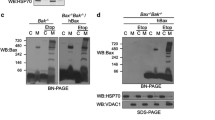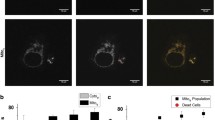Abstract
Perturbation of cellular K+ homeostasis is a common motif in apoptosis but it is unknown whether a decrease in intracellular K+ alone is sufficient to replicate apoptotic hallmarks. We investigated, which mode of cell death is induced by decreasing the intracellular K+ concentration using valinomycin, a highly K+-selective ionophore. Valinomycin treatment induced mitochondrial swelling and minor nuclear changes in cell lines (BV-2, C6, HEK 293), and in primary mouse microglia and astrocytes. In the microglial cell line BV-2, we identified and quantified three phenotypes in valinomycin-exposed cells. The first and most prevalent phenotype (62 ± 2%) was characterized by swollen mitochondria and no chromatin condensation, and the second (25 ± 3%) by swollen mitochondria and slight chromatin condensation. Only the third phenotype (11 ± 4%) fulfilled criteria of apoptosis by having normal-sized mitochondria and strongly condensed chromatin. Valinomycin-induced swelling of mitochondria was not altered by the adenine nucleotide translocase inhibitor bongkrekic acid (BA), the pan caspase inhibitor Z-VAD-FMK, changing extracellular K+ or Cl− concentrations, or the membrane-permeable Ca2+ chelator BAPTA-AM. Only co-exposure of cells to valinomycin and the Ca2+ ionophore ionomycin in high K+ Cl−-free extracellular solution suppressed mitochondrial swelling. Ionomycin alone caused shrinkage of mitochondria. Additionally, valinomycin promoted autophagic processes, which were further enhanced by preincubation with BA or with Z-VAD-FMK. Valinomycin-dependent chromatin condensation was inhibited by BA, Z-VAD-FMK, BAPTA-AM, and ionomycin. Our findings demonstrate that mitochondrial swelling and autophagy are common features of valinomycin-exposed cells. Accordingly, valinomycin promotes an autophagic cell death mode, but not apoptosis.









Similar content being viewed by others
References
Bortner CD, Hughes FM Jr, Cidlowski JA (1997) A primary role for K+ and Na+ efflux in the activation of apoptosis. J Biol Chem 272:32436–32442
McCarthy JV, Cotter TG (1997) Cell shrinkage and apoptosis: a role for potassium and sodium ion efflux. Cell Death Differ 4:756–770
Schneider J, Nicolay JP, Foller M, Wieder T, Lang F (2007) Suicidal erythrocyte death following cellular K+ loss. Cell Physiol Biochem 20:35–44
Storey NM, Gomez-Angelats M, Bortner CD, Armstrong DL, Cidlowski JA (2003) Stimulation of Kv1.3 potassium channels by death receptors during apoptosis in Jurkat T lymphocytes. J Biol Chem 278:33319–33326
Wang S, Wang JA, Li J, Zhou J, Wang H (2008) Voltage-dependent potassium channels are involved in staurosporine-induced apoptosis of rat mesenchymal stem cells. Cell Biol Int 32:312–319
Yu SP (2003) Regulation and critical role of potassium homeostasis in apoptosis. Prog Neurobiol 70:363–386
Yu SP, Choi DW (2000) Ions, cell volume, and apoptosis. Proc Natl Acad Sci USA 97:9360–9362
Hughes FM Jr, Bortner CD, Purdy GD, Cidlowski JA (1997) Intracellular K+ suppresses the activation of apoptosis in lymphocytes. J Biol Chem 272:30567–30576
Maeno E, Ishizaki Y, Kanaseki T, Hazama A, Okada Y (2000) Normotonic cell shrinkage because of disordered volume regulation is an early prerequisite to apoptosis. Proc Natl Acad Sci USA 97:9487–9492
Waldegger S, Steuer S, Risler T et al (1998) Mechanisms and clinical significance of cell volume regulation. Nephrol Dial Transplant 13:867–874
Bortner CD, Cidlowski JA (1999) Caspase independent/dependent regulation of K(+), cell shrinkage, and mitochondrial membrane potential during lymphocyte apoptosis. J Biol Chem 274:21953–21962
Bortner CD, Cidlowski JA (2004) The role of apoptotic volume decrease and ionic homeostasis in the activation and repression of apoptosis. Pflugers Arch 448:313–318
Vu CC, Bortner CD, Cidlowski JA (2001) Differential involvement of initiator caspases in apoptotic volume decrease and potassium efflux during Fas- and UV-induced cell death. J Biol Chem 276:37602–37611
Platoshyn O, Zhang S, McDaniel SS, Yuan JX (2002) Cytochrome c activates K+ channels before inducing apoptosis. Am J Physiol Cell Physiol 283:C1298–C1305
Galluzzi L, Maiuri MC, Vitale I et al (2007) Cell death modalities: classification and pathophysiological implications. Cell Death Differ 14:1237–1243
Kroemer G, Galluzzi L, Vandenabeele P et al (2009) Classification of cell death: recommendations of the Nomenclature Committee on Cell Death 2009. Cell Death Differ 16:3–11
Vandenabeele P, Galluzzi L, Vanden Berghe T, Kroemer G (2010) Molecular mechanisms of necroptosis: an ordered cellular explosion. Nat Rev Mol Cell Biol 11:700–714
Maiuri MC, Zalckvar E, Kimchi A, Kroemer G (2007) Self-eating and self-killing: crosstalk between autophagy and apoptosis. Nat Rev Mol Cell Biol 8:741–752
Marino G, Madeo F, Kroemer G (2011) Autophagy for tissue homeostasis and neuroprotection. Curr Opin Cell Biol 23:198–206
Levine B, Mizushima N, Virgin HW (2011) Autophagy in immunity and inflammation. Nature 469:323–335
Tosteson DC, Cook P, Andreoli T, Tieffenberg M (1967) The effect of valinomycin on potassium and sodium permeability of HK and LK sheep red cells. J Gen Physiol 50:2513–2525
Allbritton NL, Verret CR, Wolley RC, Eisen HN (1988) Calcium ion concentrations and DNA fragmentation in target cell destruction by murine cloned cytotoxic T lymphocytes. J Exp Med 167:514–527
Paananen A, Mikkola R, Sareneva T et al (2000) Inhibition of human NK cell function by valinomycin, a toxin from Streptomyces griseus in indoor air. Infect Immun 68:165–169
Cahalan MD, Chandy KG (2009) The functional network of ion channels in T lymphocytes. Immunol Rev 231:59–87
Kerschbaum HH, Negulescu PA, Cahalan MD (1997) Ion channels, Ca2+ signaling, and reporter gene expression in antigen-specific mouse T cells. J Immunol 159:1628–1638
Abdalah R, Wei L, Francis K, Yu SP (2006) Valinomycin-induced apoptosis in Chinese hamster ovary cells. Neurosci Lett 405:68–73
Deckers CL, Lyons AB, Samuel K, Sanderson A, Maddy AH (1993) Alternative pathways of apoptosis induced by methylprednisolone and valinomycin analyzed by flow cytometry. Exp Cell Res 208:362–370
Duke RC, Witter RZ, Nash PB, Young JD, Ojcius DM (1994) Cytolysis mediated by ionophores and pore-forming agents: role of intracellular calcium in apoptosis. FASEB J 8:237–246
Inai Y, Yabuki M, Kanno T, Akiyama J, Yasuda T, Utsumi K (1997) Valinomycin induces apoptosis of ascites hepatoma cells (AH-130) in relation to mitochondrial membrane potential. Cell Struct Funct 22:555–563
Ojcius DM, Zychlinsky A, Zheng LM, Young JD (1991) Ionophore-induced apoptosis: role of DNA fragmentation and calcium fluxes. Exp Cell Res 197:43–49
Yu SP, Yeh CH, Sensi SL et al (1997) Mediation of neuronal apoptosis by enhancement of outward potassium current. Science 278:114–117
Blasi E, Barluzzi R, Bocchini V, Mazzolla R, Bistoni F (1990) Immortalization of murine microglial cells by a v-raf/v-myc carrying retrovirus. J Neuroimmunol 27:229–237
Frei K, Bodmer S, Schwerdel C, Fontana A (1986) Astrocyte-derived interleukin 3 as a growth factor for microglia cells and peritoneal macrophages. J Immunol 137(11):3521–3527
Giulian D, Baker TJ (1986) Characterization of ameboid microglia isolated from developing mammalian brain. J Neurosci 6(8):2163–2178
Wang L, Li T, Lu L (2003) UV-induced corneal epithelial cell death by activation of potassium channels. Invest Ophthalmol Vis Sci 44:5095–5101
Friis MB, Friborg CR, Schneider L et al (2005) Cell shrinkage as a signal to apoptosis in NIH 3T3 fibroblasts. J Physiol 567:427–443
Majno G, Joris I (1995) Apoptosis, oncosis, and necrosis. An overview of cell death. Am J Pathol 146:3–15
Svoboda N, Pruetting S, Grissmer S, Kerschbaum HH (2009) cAMP-dependent chloride conductance evokes ammonia-induced blebbing in the microglial cell line, BV-2. Cell Physiol Biochem 24:53–64
Eisenhut M, Wallace H (2011) Ion channels in inflammation. Pflugers Arch 461:401–421
Nguyen W, Howard BL, Neale DS et al (2010) Use of Kv1.3 blockers for inflammatory skin conditions. Curr Med Chem 17:2882–2896
Kroemer G, Galluzzi L, Brenner C (2007) Mitochondrial membrane permeabilization in cell death. Physiol Rev 87:99–163
Tsujimoto Y, Shimizu S (2007) Role of the mitochondrial membrane permeability transition in cell death. Apoptosis 12:835–840
Gogvadze V, Robertson JD, Enoksson M, Zhivotovsky B, Orrenius S (2004) Mitochondrial cytochrome c release may occur by volume-dependent mechanisms not involving permeability transition. Biochem J 378:213–217
Lofrumento DD, La Piana G, Abbrescia DI et al. (2011) Valinomycin induced energy-dependent mitochondrial swelling, cytochrome c release, cytosolic NADH/cytochrome c oxidation and apoptosis. Apoptosis. doi:10.1007/s10495-011-0628-7
Krick S, Platoshyn O, McDaniel SS, Rubin LJ, Yuan JX (2001) Augmented K(+) currents and mitochondrial membrane depolarization in pulmonary artery myocyte apoptosis. Am J Physiol Lung Cell Mol Physiol 281:L887–L894
O’Rourke B (2007) Mitochondrial ion channels. Annu Rev Physiol 69:19–49
Nowikovsky K, Schweyen RJ, Bernardi P (2009) Pathophysiology of mitochondrial volume homeostasis: potassium transport and permeability transition. Biochim Biophys Acta 1787:345–350
Lehninger AL (1962) Water uptake and extrusion by mitochondria in relation to oxidative phosphorylation. Physiol Rev 42:467–517
Grimm S, Brdiczka D (2007) The permeability transition pore in cell death. Apoptosis 12:841–855
Kim I, Rodriguez-Enriquez S, Lemasters JJ (2007) Selective degradation of mitochondria by mitophagy. Arch Biochem Biophys 462:245–253
Tolkovsky AM (2009) Mitophagy. Biochim Biophys Acta 1793:1508–1515
Casas J, Gijon MA, Vigo AG, Crespo MS, Balsinde J, Balboa MA (2006) Overexpression of cytosolic group IVA phospholipase A2 protects cells from Ca2+ -dependent death. J Biol Chem 281:6106–6116
Wyllie AH, Kerr JF, Currie AR (1980) Cell death: the significance of apoptosis. Int Rev Cytol 68:251–306
Grinstein S, Dupre A, Rothstein A (1982) Volume regulation by human lymphocytes. Role of calcium. J Gen Physiol 79:849–868
Knauf PA, Fuhrmann GF, Rothstein S, Rothstein A (1977) The relationship between anion exchange and net anion flow across the human red blood cell membrane. J Gen Physiol 69:363–386
Arrazola A, Rota R, Hannaert P, Soler A, Garay RP (1993) Cell volume regulation in rat thymocytes. J Physiol 465:403–414
Eder C (1998) Ion channels in microglia (brain macrophages). Am J Physiol 275:C327–C342
Furtner T, Zierler S, Kerschbaum HH (2007) Blockade of chloride channels suppresses engulfment of microspheres in the microglial cell line, BV-2. Brain Res 1184:1–9
Zierler S, Frei E, Grissmer S, Kerschbaum HH (2008) Chloride influx provokes lamellipodium formation in microglial cells. Cell Physiol Biochem 21:55–62
Zierler S, Kerschbaum HH (2005) Blockade of chloride conductance antagonizes PMA-induced ramification in the murine microglial cell line, BV-2. Brain Res 1039:162–170
Bortner CD, Cidlowski JA (2003) Uncoupling cell shrinkage from apoptosis reveals that Na+ influx is required for volume loss during programmed cell death. J Biol Chem 278:39176–39184
Edinger AL, Thompson CB (2004) Death by design: apoptosis, necrosis and autophagy. Curr Opin Cell Biol 16:663–669
Loos B, Engelbrecht AM (2009) Cell death: a dynamic response concept. Autophagy 5:590–603
Boya P, Kroemer G (2008) Lysosomal membrane permeabilization in cell death. Oncogene 27:6434–6451
Yuan J, Kroemer G (2010) Alternative cell death mechanisms in development and beyond. Genes Dev 24:2592–2602
Tanaka J, Maeda N (1996) Microglial ramification requires nondiffusible factors derived from astrocytes. Exp Neurol 137:367–375
Acknowledgments
We thank our colleagues Hannelore Bauer and Sebastian Töpfer for generously providing us with HEK 293 cells, and Anton Hermann and Thomas Weiger for C6 cells.
Author information
Authors and Affiliations
Corresponding author
Rights and permissions
About this article
Cite this article
Klein, B., Wörndl, K., Lütz-Meindl, U. et al. Perturbation of intracellular K+ homeostasis with valinomycin promotes cell death by mitochondrial swelling and autophagic processes. Apoptosis 16, 1101–1117 (2011). https://doi.org/10.1007/s10495-011-0642-9
Published:
Issue Date:
DOI: https://doi.org/10.1007/s10495-011-0642-9




